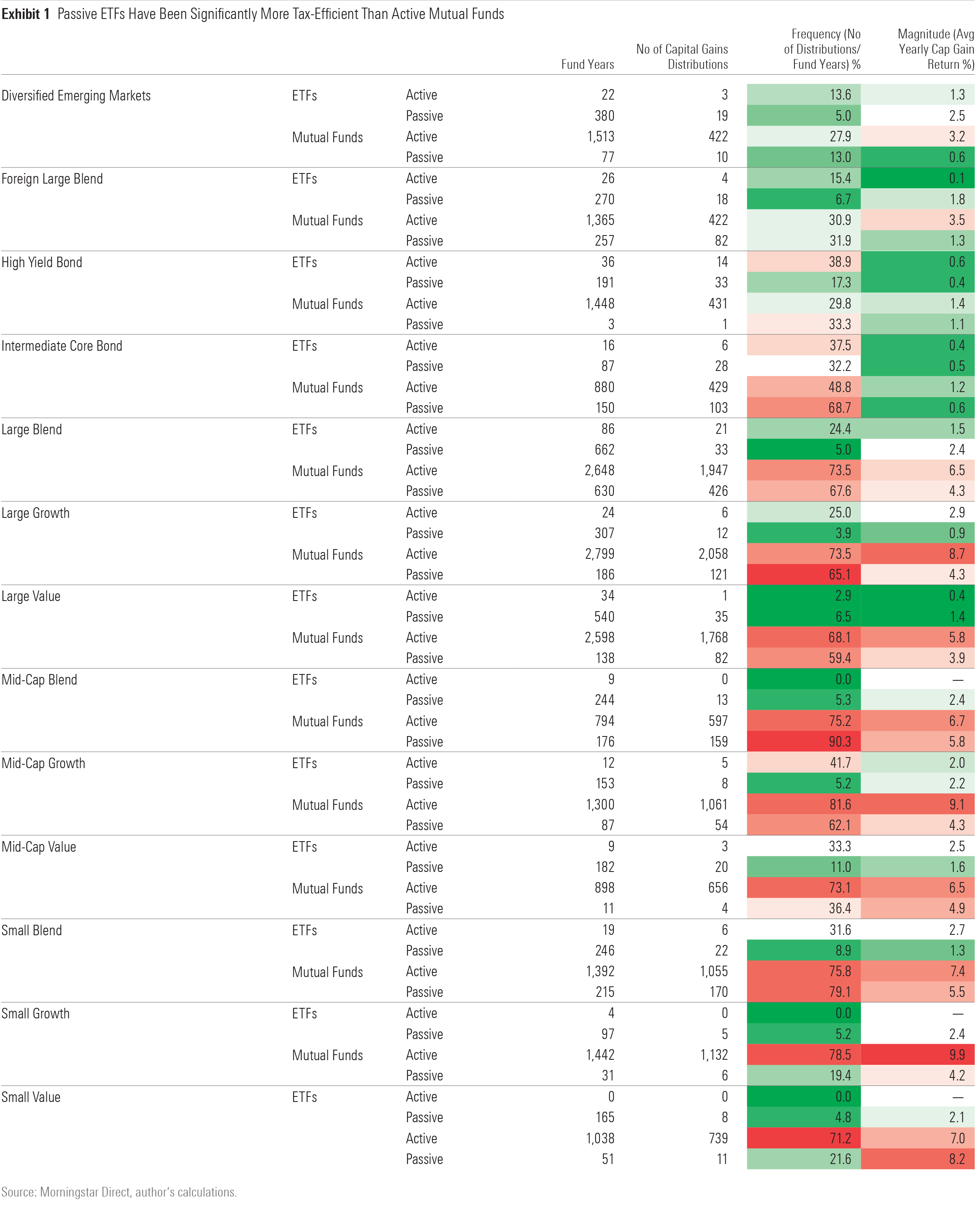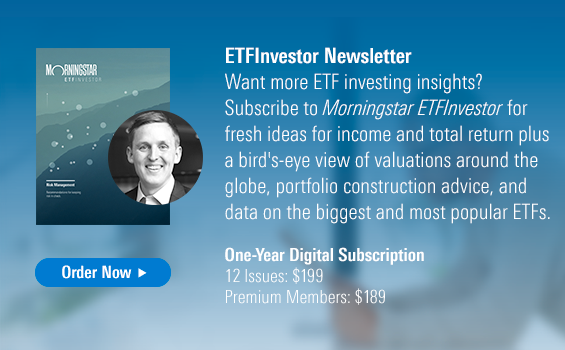ETFs Have a Tax Advantage Over Mutual Funds
ETFs’ structure gives them a leg up.

A version of this article previously appeared in the December 2021 issue of Morningstar ETFInvestor. Download a complimentary copy of Morningstar ETFInvestor by visiting the website.
Exchange-traded funds tend to be more tax-efficient than mutual funds, chiefly because they distribute fewer (if any) and smaller capital gains. ETFs’ tax efficiency has been a key selling point for tax-sensitive investors who prefer greater control over the timing and magnitude of the capital gains bills from the funds they invest in.
ETFs’ tax efficiency should not be conflated with tax immunity. Investors in ETFs will still pay taxes on regular distributions of income, and they will be on the hook for capital gains taxes when they sell an ETF for more than they paid for it. Also, some ETFs will distribute capital gains, though they tend to be less frequent and of lesser magnitude than those their mutual fund counterparts generate. So, while ETFs are more tax-efficient--thanks mostly to their unique structure and with some help from their underlying strategies--they are not immune to taxation. Their primary benefit from a tax perspective is that they can allow investors to defer capital gains taxes.
Low Turnover Is Only Part of the Story
Low turnover partly explains ETFs’ tax efficiency. As of the end of November 2021, 82% of ETF assets were invested in funds underpinned by market-cap-weighted indexes. These funds’ turnover was markedly lower than any other cohort--save for index mutual funds tied to similar benchmarks.
The low turnover of market-cap-weighted index funds is natural, as market prices determine the weights of their holdings. The only changes to the composition of these portfolios that require trades are driven by index changes, which tend to result from corporate actions (such as mergers and acquisitions), movements across a target market-cap threshold, or changes in style classification. Ultimately, less buying and selling results in fewer taxable events.
Passive, low-turnover strategies are a contributor to--but not the primary driver of--ETFs’ tax efficiency. They are not a differentiating feature, however, as many mutual funds offer exposure to similar indexes.
ETFs Are Built Different
The second and more meaningful source of ETFs’ tax efficiency is structural. It springs from the in-kind creation-and-redemption mechanism by which ETF shares are brought into and removed from the market.
The ordinary creation-and-redemption process in a traditional mutual fund is straightforward. Investors fork over cash to the fund company, fund managers put it to work in the market buying securities, and when the investor wants their money back, the manager will often have to sell securities to get the cash needed to meet redemption requests.
This buying and selling, prompted by investors regularly entering and leaving the fund, comes at a cost. That cost has a few different components:
1.) There is the frictional cost of portfolio turnover, which comprises things like brokerage commissions, bid-ask spreads, and market impact--where trades move market prices away from the manager.
2.) There is the opportunity cost of holding cash to meet regular redemptions.
3.) Taxable capital gains distributions are also a meaningful part of this cost equation. As funds liquidate securities to meet redemptions or to free up cash for new investments, they will often realize taxable capital gains, which are passed on to shareholders.
The creation-and-redemption mechanism for ETFs is a completely different animal. The ETF market is split in two: a primary market for ETF shares and a secondary one.
While mutual funds tend to deal in cash, ETFs tend to deal in kind. New ETF shares are created in the primary market when demand exceeds supply in the secondary market. This imbalance causes ETFs to trade at a premium to the value of their assets on the stock exchange. This creates an opportunity for a special breed of market makers, called authorized participants, to step in and profit. In this case, the AP will buy a basket of securities that is broadcast by the ETF’s sponsor and exchange that basket with the ETF sponsor for new ETF shares. Buying the securities relatively cheap and selling the new ETF shares relatively dear will net the AP the difference. The same process works in reverse when ETF shares are destroyed. The in-kind creation-and-redemption mechanism can also be used more tactically when ETF managers rebalance their portfolios, add new positions, or liquidate existing ones.
The in-kind creation-and-redemption mechanism externalizes many of the costs associated with regular inflows and outflows, as well as those stemming from normal turnover. These costs are borne by those investors buying and selling ETF shares, not those who are happy to hold. The most meaningful benefit of this mechanism is lower tax bills. ETFs can purge their portfolios of low-cost-basis securities by sending them out in kind and avoid realizing gains. This can give ETFs a big leg up over mutual funds, many of which have been distributing significant taxable capital gains in recent years.
Measuring ETFs’ Tax Efficiency Versus Mutual Funds
There is no doubt that ETFs’ structure should make them more tax-efficient than mutual funds. But comparing the tax efficiency of ETFs and mutual funds isn’t always straightforward. Most ETFs track indexes, and most mutual funds are actively managed. To control for these differences and facilitate cleaner comparisons between ETFs and mutual funds, I’ve grouped all funds across 13 key Morningstar Categories in Exhibit 1 into four buckets, based on vehicle type (open-end mutual fund or ETF) and whether the fund tracks an index (active or passive).
I calculated the frequency of capital gains among each cohort over the 10 years through 2020 as well as the magnitude of those distributions. I measured frequency by dividing the number of funds that made a distribution in a given year by the number of fund years--that is, the total number of complete fiscal years for each fund in the sample over the period. I calculated the magnitude of the distributions by taking the average of the yearly capital gain returns across all funds and years in the sample. The yearly capital gain return scales capital gains distributions by funds’ annual total return.

As expected, over the past 10 years, ETFs distributed capital gains far less frequently than mutual funds. Also, ETFs that did distribute gains tended to make much smaller payouts than their mutual fund counterparts. Low turnover alone isn’t enough to shield investors from taxable gains. The frequency and magnitude of distributions among large-cap index mutual funds over the past decade is proof. It’s no surprise that investors have been parking more of their taxable money in ETFs and that asset managers are flocking to such vehicles in droves. ETFs’ tax advantage over mutual funds is clear.
Disclosure: Morningstar, Inc. licenses indexes to financial institutions as the tracking indexes for investable products, such as exchange-traded funds, sponsored by the financial institution. The license fee for such use is paid by the sponsoring financial institution based mainly on the total assets of the investable product. Please click here for a list of investable products that track or have tracked a Morningstar index. Morningstar, Inc. does not market, sell, or make any representations regarding the advisability of investing in any investable product that tracks a Morningstar index.

The author or authors do not own shares in any securities mentioned in this article. Find out about Morningstar’s editorial policies.

/s3.amazonaws.com/arc-authors/morningstar/a90ba90e-1da2-48a4-98bf-a476620dbff0.jpg)
/cloudfront-us-east-1.images.arcpublishing.com/morningstar/KD4XZLC72BDERAS3VXD6QM5MUY.png)
/cloudfront-us-east-1.images.arcpublishing.com/morningstar/BZ4OD6RTORCJHCWPWXAQWZ7RQE.png)
/cloudfront-us-east-1.images.arcpublishing.com/morningstar/JNGGL2QVKFA43PRVR44O6RYGEM.png)
:quality(80)/s3.amazonaws.com/arc-authors/morningstar/a90ba90e-1da2-48a4-98bf-a476620dbff0.jpg)